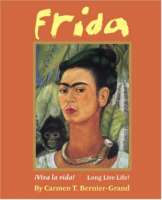
Frida Kahlo, a native of Mexico, is described here in biographical poems accompanied by her own artwork. Both text and images reveal the anguish and joy of her two marriges to muralist Diego Rivera, her life-long suffering from a crippling bus accident, and her thrist for life, even as she tasted death. Carmen T. Bernier-Grand’s powerful poems and Frida Kahlo’s extraordinary painting capture the intensity and passion that make Frida stand out as an important twentieth century painter.
See the review at WOW Review, Volume 5, Issue 3
Related: Americas, Intermediate (ages 9-14), Mexico, North America, Poetry, Young Adult (ages 14-18)
- ISBN: 9780761453369
- Authors: Bernier-Grand, Carmen T.; Carme Bernier Grand
- Illustrator: Kahlo, Frida
- Published: 2007, Marshall Cavendish Corp/Ccb
- Themes: Art and artists, Disability
- Descriptors: Americas, Intermediate (ages 9-14), Mexico, North America, Poetry, Young Adult (ages 14-18)
- No. of pages: 64

Patricia
We chose to read this book about Frida by the same author who wrote the Diego book we wrote about in our first My Take/Your Take. I’m still stuck with my first impression. That is, I enjoyed and appreciate the fact that Frida’s paintings connect or better said go along with the text and Bernier-Grand’s voice is one of celebration. Celebration that goes beyond Frida the artist, since it’s not a typical biography. I think Bernier-Grand celebrates and recognizes women, as she mentions in the book, “to the strong women in my family.” Also, I think it is important that Frida’s life, transformations and phases through life inspires and evokes in Bernier-Grand to write in free verse. I remember as a little girl my mother reading one of Frida’s biographies; she always commented about connections she made with Frida’s story. For example, Frida wore pants like Luisa Capetillo did in Cuba, in times that was not well seen or it did not happen at the beginning of the 20th century, and that led to talk about feminism. Strong women who were pioneers in revolutionizing women’s perspectives, themselves and others!!!
Ann
Even though this book, like the one Bernier-Grand did on Diego, is also written in free verse, this had a different feel for me. One obvious difference is that Bernier-Grand chose to use Frida’s own paintings to illustrate her life, and included captions that give the reader more information about Frida’s life. I felt much more connected to Frida and her art/heart by being able to experience her paintings and what they said about her life. While David’s Diaz’s illustrations for Diego were wonderful, I like being able to see the “real” Frida and how she viewed herself as a wife and artist.
I agree too that Bernier-Grand shows what a strong woman Frida was. In “Second Marriage” Frida says, “Before, [Diego] was the father and I was the child. Now I am the mother, he is the child” (p. 40). She only took Diego back for herself, not out of a sense of needing him to fill a void. I think Bernier-Grand again does a wonderful job of describing this gifted, extraordinary woman. These two books, Diego and Frida, would make a great reading set in a classroom so students could compare how the two artists complemented each other.